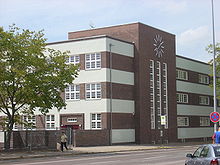Inner-city high school in Rostock
The inner-city high school (ISG) is a high school in Rostock . It emerged from the merger of the Large City School Rostock and the Goethe Gymnasium Rostock .
Since January 2008 the ISG has been housed in the “ Berringer Building” on Goetheplatz.
It is also a Unesco school.
School profile
The school profile is essentially based on three pillars:
- The scientific orientation is supported by the supplementary subject “Applied Natural Sciences”. The best physics graduates are awarded the Karl Scheel Prize.
- At the school, students can acquire French diplomas in the DELF-DALF program . Regular relationships are maintained with many partner schools in France, Sweden and Norway. There are further contacts to Dutch, Guatemalan and US schools. Regularly in February, older students can take part in a week-long trip to the UK. From 2010 two subjects will be taught bilingually (German-French); this should lead to the recognition of the Abitur in France (AbiBac).
- From the 7th grade on, students have the opportunity to take part in extended music lessons, which in the upper level are transferred to the music ensemble specialist course and the main subject music. There are many traditions in the field of music, such as the Christmas concert, theater performances, art exhibitions for high school students and the culture café in the cafeteria.
Social activities
Like its predecessor, the Goethe Gymnasium, the inner-city high school is a UNESCO project school . The students work actively in the Model United Nations network. The international BALMUN conference (Baltic Model United Nations) in June 2008 was the first in the Baltic Sea region to be organized by the dedicated students of the house and has been held annually since then.
The building
On March 5, 1930, the building designed by City Planning Director Gustav Wilhelm Berringer for two girls' schools - a state lyceum with a university and an upper lyceum - was inaugurated. They were created in 1909 as a girls' train from the Great City School.
The facilities were later renamed Oberschule I and II for girls. At the end of the Second World War, the building also served as a hospital.
During the GDR period it housed several, mostly secondary schools, the longest being the Herder-EOS (3rd EOS), an extended secondary school with extended Russian lessons from the 3rd grade. In addition, there was initially a special school in the right wing of the building before the 1st EOS “Ernst Thälmann” moved into the building complex.
From 1991 to 1999 the house was called “Gymnasium am Goetheplatz” and from 1999 until the merger in 2005 “Goethegymnasium”.
After a renovation and restoration in accordance with listed buildings, the building was furnished again in the New Objectivity style and the inner-city high school moved into at the beginning of 2008.
Today the building not only houses the inner-city high school. The evening grammar school is an integral part, the students take their Abitur together in-house. The franco-allemand institute has also been located on the ground floor since October 2009.
Since 2012 there has been a school medical service in the house with pupils trained by the Youth Red Cross .
Known students
- Liselot Huchthausen (1927–2020), classical philologist
- Walter Kempowski (1929–2007), writer, taught at Goetheplatz as a pupil of the secondary school towards the end of the war
- Peter Schulz (1930–2013), lawyer, politician (SPD), former first mayor of Hamburg
- Nele Hertling (* 1934), theater director
- Hans-Jürgen Syberberg (* 1935), filmmaker, director
- Joachim Gauck (* 1940), theologian, civil rights activist, German Federal President
- Christine Lucyga (* 1944), politician (SPD), former member of the Bundestag
- Conrad-Michael Lehment (* 1945), engineer, entrepreneur and politician
- Wolfgang Zöllick (* 1946), Mayor and Senator in Rostock and President Hansa Rostock
- Steffen Bockhahn (* 1978), politician (Die Linke), senator and deputy mayor in Rostock, former member of the Bundestag
- Eva Maria Kröger (* 1982), politician (Die Linke), parliamentary group leader of the Rostock citizenship, member of the state parliament
- Stephan Krüger (* 1988), rower, participant in the 2008 Olympic Games in Beijing, 2009 world champion in double sculls
Headmaster of the building on Goetheplatz after the fall of the Wall
- 1991–2002: Ulrich Peper († 2009)
- 2002–2018: Thomas Döring
- since 2018: Markus Riemer
literature
- Students at the Goethe Gymnasium in Rostock: Rostock - Neue Sachlichkeit , script from denkmal aktiv, 2004
- 75 years of school on Goetheplatz , Festschrift of the school association, 2005
Web links
- Internet presence of the Rostock inner-city high school
- BALMUN side
- Old photographs at MV-Terra-Incognita
Individual evidence
- ↑ The Herder-EOS was one of nine schools in the GDR that offered ancient language teaching (Latin and ancient Greek). These were the nine extended secondary schools: Heinrich Schliemann School in Berlin, Humboldt School in Potsdam, Kreuzschule in Dresden, Thomas School in Leipzig , Gerhart Hauptmann School in Zwickau, Ernst Abbe School in Eisenach, Latina August-Hermann- Francke in Halle, Humboldt School in Magdeburg and Herder School in Rostock. - Source: Markus Gruber: On the situation of Greek teaching in the Federal Republic of Germany (2006/07) ( Memento from March 4, 2016 in the Internet Archive ), page 8, accessed on June 21, 2016
Coordinates: 54 ° 4 ′ 52.7 ″ N , 12 ° 7 ′ 41 ″ E





